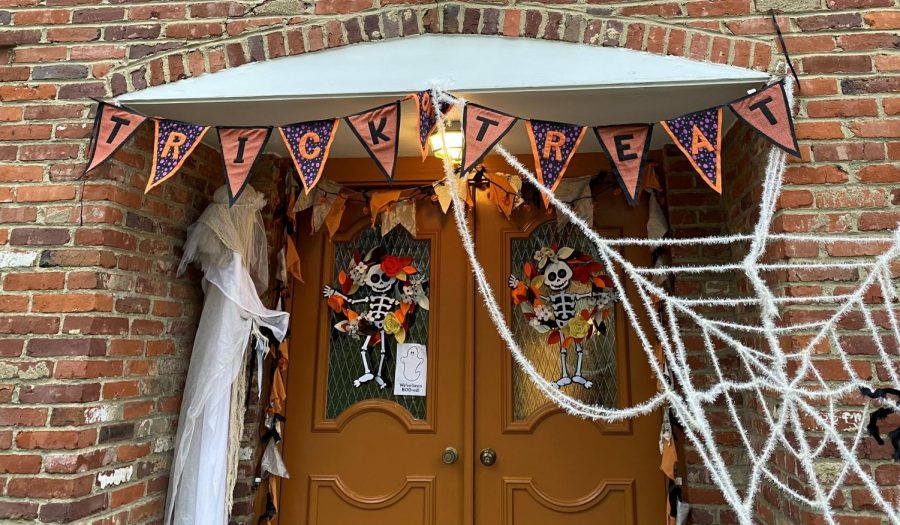Is Trick-or-Treating Safe?
One of the most cherished fall traditions may need to be adapted this year.
While the decorations around the door may look the same, traditional trick-or-treating should be anything but.
October 28, 2020
Every Halloween, excited kids decked out in costumes fill the streets, holding big bags that are waiting to be filled with sweets. They race door-to-door with their friends and families and ask for a trick or treat. It’s a tradition most Americans hold close to heart. However, for most, if not all, kids, Halloween will look very different this year.
Parents are understandably worried that it may be unsafe for their kids to go door to door asking for candy during the pandemic. In many neighborhoods, the two-hour trick-or-treating window can mean hundreds of close interactions with others.
Trick-or-treating has been a Halloween tradition for centuries. Its roots trace back to the ancient Celts, who left out food and disguised themselves to chase away phantoms. The tradition has evolved, and across America, October 31st is not so much about phantoms as it is about filling up on candy. In 2010, the United States Census Bureau estimated that 41 million kids between the ages of five and fourteen went trick-or-treating.
With many people out in the streets, including those handing out the candy, the risk of spreading COVID-19 is a concern. Many homeowners directly hand out candy themselves, or they have communal candy bowls that kids reach into. Though the risk of infection through surfaces is lower than it is through the air, the CDC reports that “current evidence suggests that SARS-CoV-2 may remain viable for hours to days on surfaces made from a variety of materials.”
COVID-19 is primarily believed to spread be through close contact and exchange of respiratory droplets. On a night with kids running both around and into each other, transmission of the virus seems very possible, especially if precautionary measures are not taken.
Some cities have issued regulations or outright bans on trick-or-treating. In Springfield, Massachusetts, door-to-door trick-or-treating will not be permitted. Other activities, such as online parties or car parades, have been permitted. At the beginning of September, Los Angeles placed a similar ban on trick-or-treating, but a day later, they changed their stance to “not recommended.”
The CDC also put forth a list of various activities on Halloween, rating them as either low-risk, moderate-risk, or high-risk activities. Low-risk activities include pumpkin carving and Halloween movie night with your family, while moderate risk activities include one-way-trick-or-treating (pre-made bags lined up for kids to take outside) and costume parties outdoors with masks and proper social distancing. The CDC lists traditional trick-or-treating, indoor costume parties, and indoor haunted houses all as high-risk activities.
No one enjoys disruptions to tradition, but the CDC recommendations should make us question the Halloween norm this Saturday. As traditional trick-or-treating puts children, their parents, and their parents at an elevated risk, we should ask ourselves if participating the way we always have is worth the potential costs.
It is inevitable that some kids will still trick-or-treat, as it is such a beloved tradition. Nevertheless, precautions should be taken to modify the event in light of the serious risks. Even though kids will be outside, masks should be worn as a preventative measure. And to be clear, some Halloween costumes include masks, but they are not a substitute for a real one. In addition, the CDC does not recommend wearing both types of mask, for it could be dangerous if it is already hard to breathe in the Halloween mask. Therefore, fewer kids will probably be able to wear decorative masks, but it is worth the inconvenience if it keeps them safe.
Traditional trick-or-treating could also be made safer by eliminating communal bowls altogether and ensuring that children stay distant while receiving candy. One way this could be done is through individually made bags that are spread out for trick-or-treaters to grab.
While not everyone always has the space, households handing out candy can also come up with their own innovative ways to participate from a distance. For example, one father in Ohio made a candy chute to deliver Halloween goods from a distance.
Trick-or-treating is a fun and memorable annual activity, and we certainly haven’t a lot of those recently. This weekend, however, it is important that we get a little creative and follow a few easy rules to keep everyone safe.












